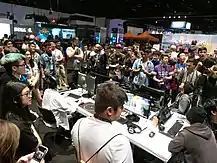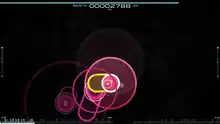osu!
Osu![lower-alpha 1] (stylized as osu!) is a free-to-play rhythm game primarily developed, published, and created by Dean "peppy" Herbert. Inspired by iNiS' rhythm game Osu! Tatakae! Ouendan, it was written in C# on the .NET Framework,[4] and was released for Microsoft Windows on 16 September 2007. The game has throughout the years been ported to macOS, Linux, Android and iOS.
 The osu! logo since 2016[1] | |
| Original author(s) | Dean "peppy" Herbert |
|---|---|
| Developer(s) | osu! development team |
| Initial release | September 16, 2007 |
| Repository | https://github.com/ppy/osu |
| Written in | C# |
| Middleware | OpenTK[2] |
| Operating system | Microsoft Windows macOS Linux (open beta) Android (open beta) iOS (open beta) |
| Size |
|
| Available in | 35 languages |
List of languages English, Japanese, Simplified Chinese, Traditional Chinese, Thai & 30 More | |
| Type | Rhythm game |
| License | Freeware (stable build) MIT (osu!lazer code) |
| Website | osu |
Aside from Osu! Tatakae! Ouendan, the game has been inspired by titles such as Taiko no Tatsujin, Beatmania IIDX,[5] EZ2DJ (EZ2CATCH), Elite Beat Agents, O2Jam, StepMania, and DJMax. All "beatmaps" in the game are community-made through the in-game map editor or through external tools. Four different game modes exist, offering various ways to play a beatmap. These modes can also be combined with optional modifiers, which can increase or decrease the difficulty.
Gameplay and features
There are four official game modes: "osu!" (called "osu! standard"), "osu!taiko", "osu!catch", and "osu!mania". With the addition of osu!lazer, players can now add custom gamemodes to the osu! client.[6][7] The original osu!standard mode remains the most popular to date and as of January 2023, the game has over 19.3 million monthly active users according to the game's global country leaderboards.[8]
"osu!standard" takes direct inspiration from Osu! Tatakae! Ouendan games. In this gamemode, the player clicks circles to the beat of a song. This is the flagship gamemode featured on the osu! website.[9] "osu!mania" is a vertical scrolling rhythm game that mostly takes inspiration from Beatmania and Stepmania. The gamemode consists of notes that fall vertically in different lanes, with one key used to tap for each lane.[10] "osu!taiko" simulates playing on taiko and is based on Taiko no Tatsujin.[11] The final gamemode, osu!catch, is based on "EZ2CATCH", which was part of the EZ2DJ cabinet. In this gamemode, the player moves a catcher left or right in order to catch fruits falling from the top of the screen.[9]
Each mode offers a variety of "beatmaps", which are game levels that are played to songs of different lengths, ranging from "TV size" anime openings to "marathons" surpassing 7 minutes. In osu!standard, beatmaps consist of three items – hit circles, sliders, and spinners. The objective of the game is for the player to click on these items in time to the music. These items are collectively known as "hit objects" or "circles" and are arranged in different positions on the screen (except for the spinner) at different points of time during a song. Taiko beatmaps have drumbeats and spinners. Catch beatmaps have fruits and spinners (which are bananas), which are arranged in a horizontally falling manner. Mania beatmaps consist of keys (depicted as a small bar) and holds. The beatmap is then played with accompanying music, simulating a sense of rhythm as the player interacts with the objects to the beat of the music.[12][13] Each beatmap is accompanied by music and a background (which can be disabled). The game can be played using various peripherals: the most common setup is a graphics tablet or computer mouse to control cursor movement, paired with a keyboard[14][5] or a mini keyboard with only two keys, and only the keyboard for osu!taiko, osu!catch, and osu!mania beatmaps.
The game offers a buyable extension service called osu!supporter, which grants extra features to the user.[15] osu!supporter does not affect the ranking system or provide any in-game advantage. While osu!supporter itself is not a recurring service (meaning it is a one-off payment), it has a limited time validity ranging from 1 month to 2 years; however, multiple purchases of osu!supporter service time can be entitled to one user, allowing for longer uninterrupted service.
Community and competitive play
Community events

osu! and its players have organized different events, such as fanart, tournaments, beatmapping contests, and conventions. The biggest unofficial event held in the community is "cavoe's osu! event"[16] (usually referred to as "osu! event" or "COE"), held at The Brabanthallen[17] in 's-Hertogenbosch, Netherlands. The event has been arranged three times since 2017 yearly. However, due to the COVID-19 pandemic, the 2020 and 2021 editions of the event were canceled. COE 2022 occurred from 1 to 7 August and COE 2023, the most recent event, has been held from July 31 - August 6, 2023. There were also official stands at TwitchCon and Anime Expo.
Competition
osu! contains three main facets of competition between players. In multiplayer lobbies, up to 16 users play a map simultaneously. On individual maps, players compete for highscores on global leaderboards or against highscores set by themselves and friends. Players also compete with their ranks, which are calculated by accumulating "performance points" (pp). pp is based on a map's difficulty and the player's performance on it.[18] In July 2019, a player, Vaxei, exceeded 1,000 pp in a single play for the first time, followed by another player, idke, less than twenty-four hours later.[19][20] As of October 2023, the pp record belongs to the player Accolibed on VINXIS - Sidetracked Day [Infinity Inside], worth 1,711 pp.
Tournaments
Since established in 2011, there have been twelve annual osu! World Cups (usually abbreviated as OWC), one for each game mode (osu!mania having two for four key and seven key). Teams for World Cups are country-based, with up to eight players per team.[21] There are also very many different community-hosted tournaments, differing in rank range, types of maps played, and how the teams are composed.[22] Winners of larger official tournaments typically receive prizes such as cash, merchandise, profile badges and/or osu!supporter subscriptions. For this reason, large tournaments often attract high-skill level players as well as large audiences on Twitch, this is in contrast to the smaller community tournaments, which often have small or no prizes and are not watched by many people. These smaller tournaments comprise the vast majority of all osu! Tournaments, and through the usage of global rank entry restrictions where you may only compete against players in your own rank range, community tournaments provide a serious competitive environment for players who may not be as highly skilled. Without these community tournaments, players would have to practice for years to have any shot at playing at the same competition level of those who are professional players in the community.
Adaptations
osu!stream
In 2011, osu!stream was released as an adaptation of osu! for iOS devices, also developed by Dean Herbert. An Android version was released on 12 January 2023.[23] The main difference between osu! and osu!stream is that osu!stream beatmaps are not user-created and are instead made by the developers of osu!stream. The version also includes some new gameplay elements.[24] On 26 February 2020, Herbert announced that he released the source code and plans to halt the development of the game, releasing one final update that made all the levels free to download.[25]
osu!droid
osu!droid is a fanmade client that is unaffiliated with peppy, the official developer of osu!.[26] It features the standard osu! gamemode and is only available on the Android platform.
osu!lazer

osu!lazer[27] is an open source rewrite of the original game client. It is intended to replace the current stable client once it gains user acceptance. New features to the game are no longer being added to the stable client;[28] new development is focused on osu!lazer.
The development of osu!lazer began in 2015, and is currently available on Microsoft Windows, macOS, Linux, Android, and iOS, yet it is not fully released, staying in a beta phase for the foreseeable future. osu!lazer is written entirely in .NET (formerly .NET Core).[29]
osu!framework
osu!framework is an open source game framework developed with osu!lazer in mind. The goal of osu!framework development is to create a versatile and accessible game framework that goes further than most, providing things out-of-the-box such as graphics, advanced input processing, and text rendering.[29]
Reception
Jeuxvideo.com reviewed osu! favorably with 18/20 points in 2015.[30] In 2010, MMOGames.com reviewer Daniel Ball said that while the game was very similar to Elite Beat Agents, it was differentiated by its community's large library of high-quality community made content and customization.[31] The game has been used and recommended by esports players such as Ninja and EFFECT, as a way to warm-up and practice their aim.[32][12]
Notes
- Pronounced variously: English: /ˈoʊsuː/, /oʊs/; IPA: [osː].
References
- "Stable 20161029.3 · changelog | osu!". osu.ppy.sh. Archived from the original on 25 July 2022. Retrieved 25 July 2022.
- "a long-overdue update". ppy blog. 30 June 2016. Archived from the original on 8 November 2020. Retrieved 20 August 2021.
Until now we used some XNA code for input handling and low-level structs. These dependencies are almost compeletely [sic] removed from the project now, with OpenTK or similar open-source frameworks replacing them.
- "GitHub - ppy/osu-resources: assets used by osu!". GitHub. Retrieved 19 January 2023.
- "Osu!'s programming language?". osu! Community Forum. Retrieved 27 July 2021.
- Gonzáles, Mariela (5 September 2019). "Gaming Sounds: osu!, cuando el ritmo se convierte en nuestro séptimo sentido". The Objective (in Spanish). The Objective Media. Archived from the original on 7 January 2020. Retrieved 7 January 2020.
- Andika, Ferry (27 December 2019). "Osu!, Game Rhythm Terkenal di PC dengan Ribuan Pemain Harian" (in Indonesian). Jakarta: Indozone Media Indonesia. Archived from the original on 7 January 2020. Retrieved 7 January 2020.
- "Game Modes". osu.ppy.sh. Archived from the original on 21 November 2019. Retrieved 15 August 2019.
- "osu! leaderboards".
- "Game mode / osu! (game mode) · wiki | osu!". osu.ppy.sh.
- "Game mode / osu!mania · wiki | osu!". osu.ppy.sh.
- "Game mode / osu!taiko · wiki | osu!". osu.ppy.sh.
- Rodrigues, Gabriela (19 September 2019). "Como baixar Osu! e treinar sua mira no Fortnite e CS:GO". TechTudo (in Brazilian Portuguese). Rio de Janeiro: Globo Comunicação e Participações S.A. Archived from the original on 7 January 2020. Retrieved 7 January 2020.
- Phúc, Thịnh (30 August 2019). "Bí quyết giúp game thủ có khả năng phản xạ chớp nhoáng". Zing.vn (in Vietnamese). Archived from the original on 7 January 2020. Retrieved 7 January 2020.
- Smart, Jibb (17 September 2019). "Why not just use thumbsticks?". Gamasutra. Archived from the original on 7 January 2020. Retrieved 7 January 2020.
While there's debate among its fans as to whether playing with a mouse is as good as playing with a stylus, there's one thing everyone will agree on: thumbsticks are almost useless for this game.
- "Support the game". osu.ppy.sh. Archived from the original on 12 August 2019. Retrieved 12 August 2019.
- cavoeboy. "COE 2022". cavoeboy.com. Archived from the original on 2 September 2022. Retrieved 2 September 2022.
- "COE 2022 1 tot en met 7 augustus". Brabanthallen 's-Hertogenbosch. Archived from the original on 2 September 2022. Retrieved 2 September 2022.
- "Performance Ranking". osu.ppy.sh. Archived from the original on 30 November 2018. Retrieved 1 September 2019.
- Carpenter, Nicole (16 July 2019). "Gamers with godlike reflexes are racing to break world records in this rhythm game". PC Gamer. Archived from the original on 26 September 2019. Retrieved 12 August 2019.
- "osu! PP world record broken by 15-year-old". Dot Esports. 25 July 2019. Archived from the original on 12 August 2019. Retrieved 12 August 2019.
For instance, former Overwatch League pro Hyeon "EFFECT" Hwang said he plays the game for one hour before matches to warm up his hands.
- Amos, Andrew (16 November 2018). "Circle Work: A chat with Australia's osu! World Cup team". Red Bull. Archived from the original on 30 July 2019. Retrieved 4 September 2019.
- "Tournaments". osu.ppy.sh. Archived from the original on 12 December 2017. Retrieved 4 September 2019.
- "osu!stream on Twitter: "a few years late but we're finally available on android"". twitter.com. Retrieved 13 January 2023.
- "osu!stream". osu.ppy.sh. Archived from the original on 6 May 2021. Retrieved 9 May 2019.
- blog, ppy. "osu!stream 2020 release". blog.ppy.sh. Archived from the original on 27 February 2020. Retrieved 27 February 2020.
- "GitHub - osudroid/osu-droid". GitHub. 23 January 2023. Retrieved 23 January 2023.
- GitHub - ppy/osu: rhythm is just a *click* away!, ppy, 6 September 2019, archived from the original on 3 April 2017, retrieved 6 September 2019
- "Add a feature that allows you to report bugs in-game for stable. · ppy/osu · Discussion #14294". GitHub.
- ppy/osu-framework, ppy, 15 June 2021, archived from the original on 24 June 2021, retrieved 24 June 2021
- "Test : Osu!". jeuxvideo.com (in French). 7 June 2015. Archived from the original on 21 June 2017.
- Ball, Daniel (27 April 2010). "Online rhythm and music game Osu! reviewed - MMOGames.com". MMOGames.com. Archived from the original on 22 October 2018. Retrieved 22 October 2018.
- Webb, Kevin (24 August 2019). "Professional gamers like Ninja use this music game to practice their aim and improve their mouse skills — Here's how you can play for free". Business Insider. Archived from the original on 2 December 2019. Retrieved 26 August 2019.